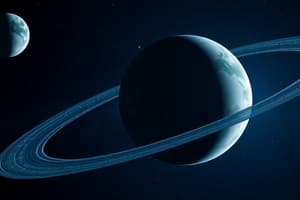Podcast
Questions and Answers
Gravity is responsible for holding celestial bodies together and keeping them in their respective orbits.
Gravity is responsible for holding celestial bodies together and keeping them in their respective orbits.
True (A)
The planets would fly apart from their host stars without the force of gravity.
The planets would fly apart from their host stars without the force of gravity.
True (A)
Stars emit light and heat due to chemical reactions happening within them.
Stars emit light and heat due to chemical reactions happening within them.
False (B)
Red giants and blue dwarfs are examples of the various sizes and temperatures that stars can have.
Red giants and blue dwarfs are examples of the various sizes and temperatures that stars can have.
Most stars have moons revolving around them as part of their planetary systems.
Most stars have moons revolving around them as part of their planetary systems.
The moon orbits Earth in a circular path that takes approximately 30 days to complete one orbit.
The moon orbits Earth in a circular path that takes approximately 30 days to complete one orbit.
The strength of tidal forces on Earth remains constant regardless of the moon's distance from Earth.
The strength of tidal forces on Earth remains constant regardless of the moon's distance from Earth.
Mercury has a longer orbital period around the sun compared to Neptune.
Mercury has a longer orbital period around the sun compared to Neptune.
Our solar system consists of six known planets.
Our solar system consists of six known planets.
Stars do not interact with each other through the forces of gravity.
Stars do not interact with each other through the forces of gravity.
Celestial bodies only include objects within our solar system.
Celestial bodies only include objects within our solar system.
Study Notes
Celestial Bodies: Understanding Orbits, Planetary Motion, Solar System, Gravity, and Stars
Celestial bodies refer to objects in space, such as planets, moons, stars, galaxies, and other astronomical phenomena. They range from tiny asteroids to massive stars and galaxies, and they all interact with each other through the forces of gravity.
Moon's Orbit
The moon orbits Earth in an elliptical path that takes approximately 27.3 days to complete one orbit. This means that while we see different phases of the moon every night, it actually moves a few degrees along its orbital path from our perspective on Earth. The moon's distance from Earth varies depending on where it is in its orbit, which can affect the strength of tidal forces on Earth and contribute to rising sea levels when it is closest (perigee) and lowest sea levels when it is farthest away (apogee).
Planetary Motion
Planets move in their respective orbits due to the gravitational force of the star they revolve around. For example, Earth rotates around the sun in approximately 365.25 days, causing our seasons and weather changes. Mercury has the shortest orbital period (88 Earth days), while Neptune takes nearly 165 Earth years to complete one orbit.
Solar System
Our solar system consists of eight known planets (Mercury, Venus, Earth, Mars, Jupiter, Saturn, Uranus, and Neptune) plus several smaller bodies like dwarf planets, asteroids, comets, and other celestial debris. All these bodies orbit around the sun, which provides the heat and light necessary for life on Earth.
Gravity
Gravity is the force that holds celestial bodies together and keeps them in their respective orbits. Without gravity, the planets would fly apart from their host stars, and galaxies wouldn't form. Even though gravity is weak compared to other fundamental forces like electromagnetism or nuclear interactions, it plays a crucial role in cosmic structures.
Stars
Stars are massive, glowing balls of hot gas that emit light and heat due to nuclear reactions occurring within them. They come in various sizes and temperatures, ranging from red giants to blue dwarfs. Most stars have planets revolving around them, forming planetary systems that could potentially harbor life.
Understanding these aspects of celestial bodies helps us appreciate the vastness and complexity of space, as well as the intricacy of the mechanisms governing its inhabitants.
Studying That Suits You
Use AI to generate personalized quizzes and flashcards to suit your learning preferences.
Description
Explore the fascinating world of celestial bodies including orbits, planetary motion, the solar system, gravity, and stars. Learn about the moon's elliptical orbit, planetary orbital periods, the components of our solar system, the force of gravity, and the characteristics of stars.




